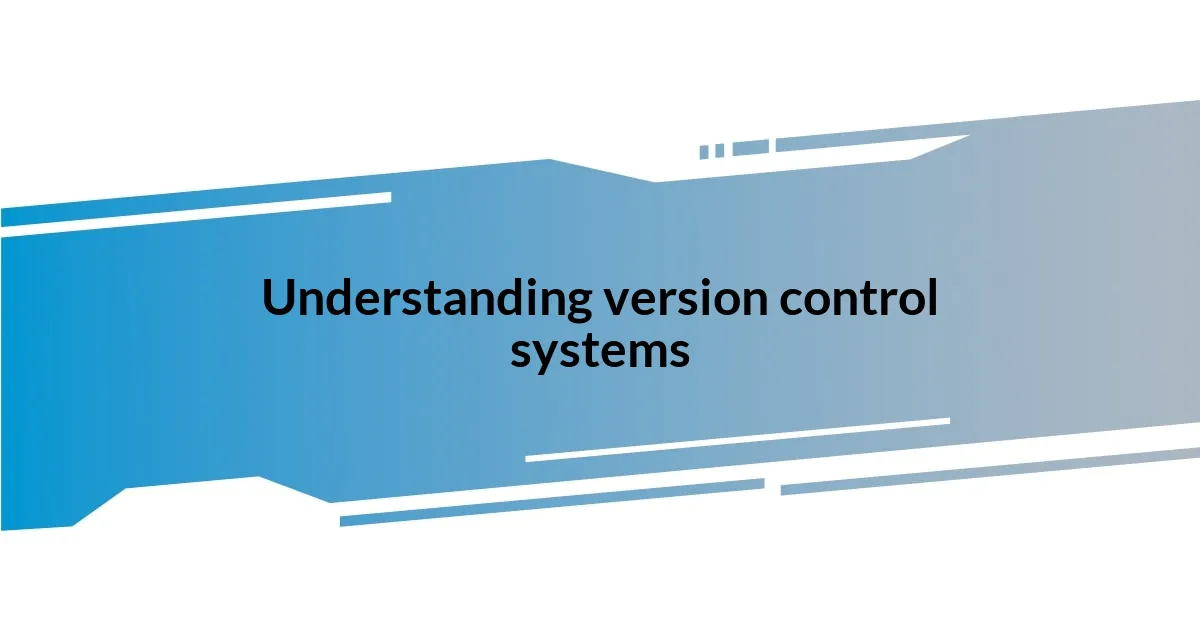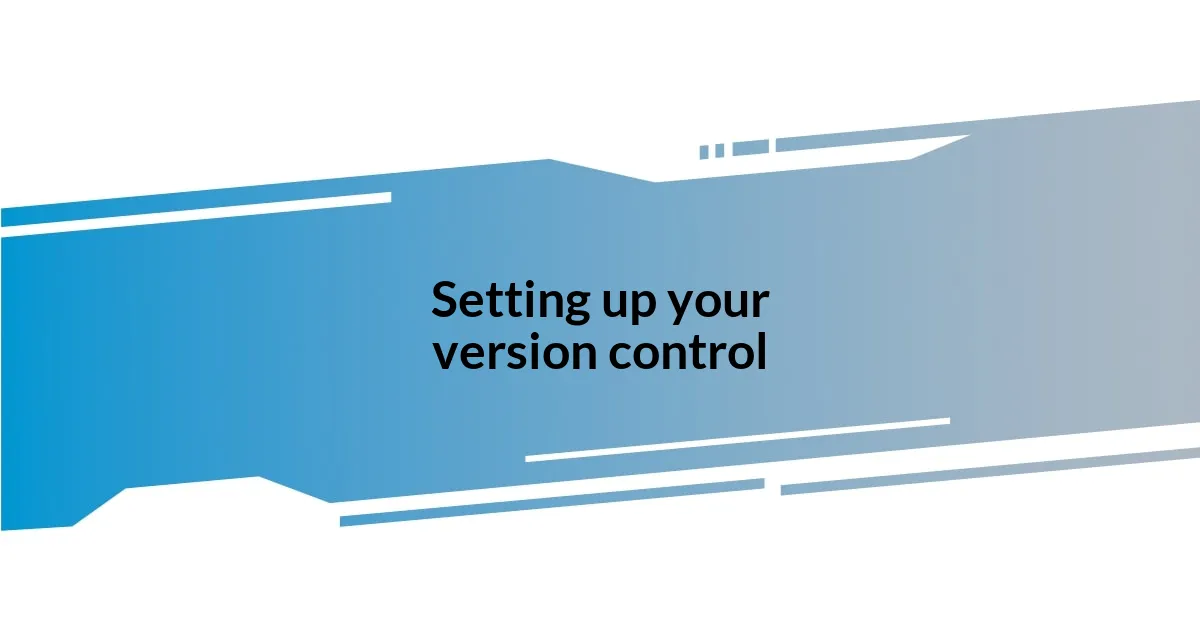Key takeaways:
- Version control systems (VCS) allow for collaborative work without overwriting each other’s contributions, providing security to revert changes.
- Essential steps for setting up a VCS include initializing a repository, using a .gitignore file, and mastering branching and merging for effective teamwork.
- Basic commands like
git init,git add,git commit, andgit statusstreamline the workflow and track progress. - Structured collaboration models, like Git Flow, enhance project clarity and foster a sense of shared ownership among team members.

Understanding version control systems
Version control systems (VCS) are essential tools that help manage changes to files over time. I remember the first time I lost hours of work because I didn’t have a way to revert back to an earlier version. It was a painful lesson, and that’s when I truly understood the value of having a system that tracks every change I make.
At its core, a version control system allows multiple people to collaborate on code without the fear of overwriting each other’s work. I often find myself asking, “How would I handle changes if there were several teammates working simultaneously?” The answer lies in branching: creating isolated environments to work on new features or fixes, which can later be merged back into the main project seamlessly.
Using a VCS also provides a sense of security and peace of mind. I distinctly recall the relief I felt when I could confidently roll back to a previous version after realizing that the latest changes were a bit flawed. Isn’t it reassuring to know that you can experiment without the risk of completely losing progress? That’s the beauty of version control; it allows for creativity and exploration within a structured framework.

Setting up your version control
Setting up a version control system can be incredibly rewarding, but it’s essential to start with the right steps. When I first began using Git, I remember feeling a mix of excitement and uncertainty. It was crucial for me to establish a repository, as it serves as the central hub for my project. Once I initialized my repository, I then added my files, ensuring that I was ready to track all changes. I can’t stress enough how satisfying it felt to see my project’s history unfold right in front of me.
Building on that, it’s also important to configure your settings appropriately. I learned the hard way that setting up a .gitignore file to exclude unnecessary files was a game changer. There’s no worse feeling than cluttering your commits with files that don’t belong. I still smile at how much cleaner my repositories became! My advice is to take the time to consider what should and shouldn’t be tracked, as it saves an enormous amount of frustration down the line.
Lastly, mastering branching and merging is fundamental to effective collaboration. I remember struggling to manage changes from teammates when I first jumped into a collaborative project. Implementing branches allowed each team member to work on their features independently, which was a revelation. I encourage you to experiment with these concepts; they transformed chaos into order for my projects, enhancing teamwork and still giving each of us room to express our creativity.
| Feature | Description |
|---|---|
| Repository Initialization | Set up the central hub for tracking changes. |
| .gitignore | Exclude unnecessary files from being tracked. |
| Branching | Create isolated environments for features or fixes. |
| Merging | Combine changes from different branches effectively. |

Basic commands for version control
Understanding the basic commands in a version control system is fundamental to maximizing its potential. I still remember the pride I felt when I first executed my initial commit, watching the command line confirm that my changes had been saved with a simple message. It felt as if I were officially stepping into the realm of version control. Here are some essential commands that I’ve found particularly useful along my journey:
- git init: Initializes a new repository in your project directory.
- git add [file]: Stages changes, preparing them for a commit.
- git commit -m “[message]”: Saves the staged changes with a concise description.
- git status: Shows the current state of your repository and staged files.
I’ve come to rely on these commands, appreciating how they streamline my workflow. For instance, after a long day of coding, I often run git status to get a quick overview of what I’ve accomplished and what still needs attention. There’s something deeply satisfying in seeing that my progress is tracked step by step, reassuring me that I am not just swimming in a sea of code but rather navigating a well-structured journey.

Collaborative workflows with version control
When I started collaborating with others using version control, I felt a bit overwhelmed. It’s crucial to grasp how features like pull requests can transform team dynamics. I recall my first experience reviewing a colleague’s code; I was surprised at how constructive feedback could refine our project. It sparked a deeper understanding of the code and fostered a sense of shared ownership among us, making each of us feel more responsible for the outcome.
One of the most enlightening moments came when our team decided to implement a structured branching model. We opted for Git Flow, which allowed us to manage releases, features, and fixes in a clear and organized manner. This model helped me visualize the entire project clearly, and I found myself more at ease knowing where every piece of work fit into the puzzle. Have you ever felt lost in collaboration? I certainly have, but with this approach, I no longer felt like a small cog; rather, I was part of a robust machine churning out quality code.
I also learned the power of regular communication during those collaborative sessions. I remember a time when we all gathered for a code review and ended up brainstorming ideas that improved our original features significantly. It was a palpable moment of synergy. Sharing insights that emerged from our individual branches felt more like a celebration than just a review process. This interaction taught me that collaboration isn’t just about merging code; it’s about merging minds, thoughts, and creativity to elevate our projects together.